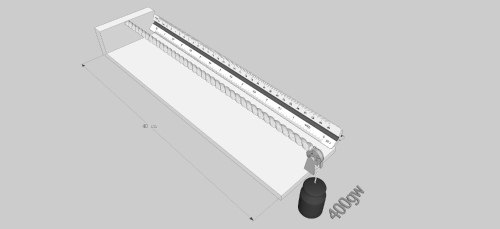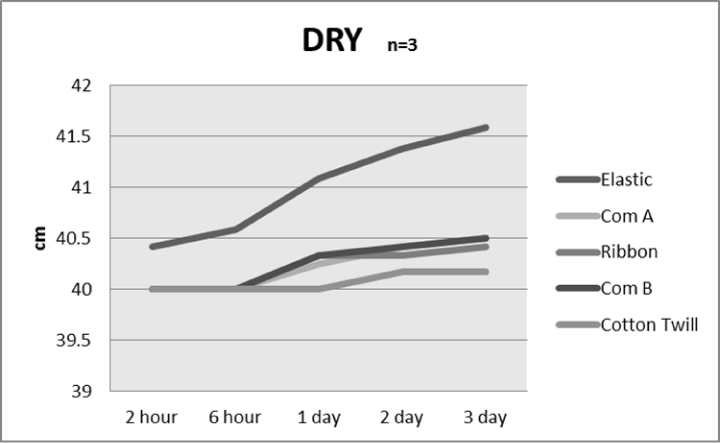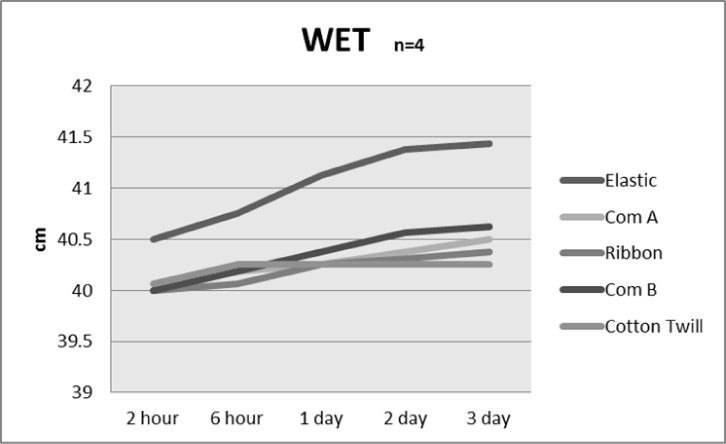
Research Article
Austin J Otolaryngol. 2014;1(1): 2.
Avoiding Tracheal Tube Care Accidents: Elongation of Tracheal Tube Securing Straps
Yen-Liang Chang1, Ming-Hsu Chen1 and Shih-Han Hung2*
1Department of Otolaryngology Head and Neck Surgery, Cathay General Hospital, Taipei, Taiwan
2Department of Otolaryngology, Taipei Medical University Hospital, Taipei, Taiwan
*Corresponding author: Shih-Han Hung, Department of Otolaryngology, Head & Neck Surgery Taipei Medical University, No.252, Wu-Hsing Street, Taipei City 110, Taiwan
Received: June 28, 2014; Accepted: July 29, 2014; Published: Aug 01, 2014
Abstract
Purpose: Tracheal tube securing straps are essential in maintaining adequate tube function. In this study, we attempted to test and analyze some commonly used tracheal tube securing straps.
Methods: Five different straps were tested under stress in dry and wet conditions. Certain elongation properties under stress on tracheal tube securing straps should be noticed.
Results: The dampening of the tracheal straps seems not likely to affect the elongation properties (P>0.5). The most affected strap is the elastic strap (3.96% & 3.59% elongation, wet: dry).The cotton twill strap is the least to be extended (0.42% & 0.63% elongation, wet: dry).
Conclusion: Traditional cotton twill straps remain to be most reliable choice. We propose and recommend that all tracheal straps be Pre-Stretched before use. Protocols able to stabilize tracheal tube strap will be likely to improve patient safety and avoid tube mal position accidents.
Keywords: Tracheal tube; Elongation; Strain; Securing strap
Introduction
Endotracheal intubation and tracheostomy are two common procedures in the practice in many fields of clinical medicine. After the procedure was completed, a tracheal tube was placed to protect and secure the airway. Traditionally, tracheal tubes were secured by simple straps or sticky tapes tied on the tube and surrounding the face or neck. However, according to many clinical experiences, although this securing method is simple, efficient, and easy to care, besides the adhesive properties of the sticky tape, the efficacy of the securing method largely depend on the stability and elongation properties of the securing straps. In any cases of whether during the treatment or bath, or contaminated by body fluids, the length of the securing straps could have increased, and subsequently leads to the dislocation of the tracheal tube and even leads to a life threatening conditions, if the upper-airway is compromised.
In this study, we attempted to record and analyze the different response to dry and wet conditions of many clinically/commercially available tracheal tube securing straps.
Material and Method
Straps
Tracheostomy securing straps commonly used in clinical practice were used, including two commercially available tracheostomy straps, common elastic straps, ribbon straps, and common cotton twill straps.
Length elongation measurement
The tension forces of a tightened tracheostomy tube straps was measured with an electronic tension meter (WH-A12, Wei Heng, Taiwan) and set at 400gw. The length of the strap surrounding the neck is around 40 cm.
All straps were secured at one end on a fixed shaft as shown in Figure 1. On the other end, a weight of 400gwwas applied and secured. A 40 cm gap was marked on the strap and the length recording began once the weight was applied. The length recording was done at 6, 12, 24, 48, and 72 hours. In the dry group the straps were kept dry under room air and room temperature. In the wet group, the straps were continuous irrigated with saline to keep the straps in the wet condition.
Figure 1: Diagram of the strap elongation testing device.
Results
As shown in Figure 2 & 3, in both dry and wet groups the tracheal strap length gradually increased under tension. The most affected strap is the elastic strap with 3.96% elongation in the dry group and 3.59% in the wet group. The cotton twill strap is the least to be extended with only 0.42% elongation in the dry group and 0.63% in the wet group. For every kind of straps, there are no statistically differences between the wet and dry groups in any recorded time periods. (P>0.5, t-test) At day 3 (dry), the elongation for the Elastic, Com A, Ribbon, Com B, and Cotton Twill straps were 1.58, 0.5, 0.41, 0.5, and 0.17 cm respectively. The lengths of elongation for the traditional Cotton Twill straps were statistically significant lower than the other three straps. (p<0.05, t-test).
Figure 2: Tracheal tube strap elongation under dry conditions and 400gw (3.92 N) of loading force. (error bar not shown, standard deviation<3% for all data, Com A & Com B: Commercial strap brand A & B).
Figure 3: Tracheal tube strap elongation under wet conditions and 400gw(3.92 N) of loading force. (error bar not shown, standard deviation<3% for all data, Com A & Com B: Commercial strap brand A & B).
Discussion
If the patient has complete obstruction of the upper airway, a displaced tracheostomy tube will result in immediate respiratory distress and can lead to respiratory arrest. A mal-positioned tube can be a source of patient distress and patient-ventilator asynchrony, and is important to recognize and correct [1]. Emergency procedures were developed and recommended once this life threatening conditions has occurred [2-6]. Many conditions had been reported like Intra operative airway obstruction related to tracheostomy tube mal position [7,8]. Tracheal tube securing devices were sometimes suggested to use elastic straps, with Velcro fasteners [9]. However, in most of our practices, non-elastic straps were most often used to secure the tracheal tubes. In 1998, a study by Dixon et al compared the use and cost effectiveness of tracheostomy tube securing devices [10]. However, the study did not focus on the property changes and the elongation of the secured devices. And also the properties of “twill” and “Velcro” were not fully described in the aspect of patient safety. Some has developed a securing “clip”, again the properties of the securing strap or tape remain unknown [11].
In our study, we observed that the speed of the elongation tends to decrease around two days after force application. According to this observation, we propose and recommend that all tracheal straps be Pre-Stretched before use. The pre-stretch process has already been widely applied in so many fields in machinery. For example, brake cables of bicycles. Protocols able to stabilize tracheal tube strap will be likely to improve patient safety and avoid tube mal position accidents.
The limitation of this preliminary study is short observation period and low sample numbers. It is possible that if we increase the number of tests and prolong the observation period, there will be some differences between the wet and the dry group. However, we hope that it can still provide clinical doctors useful information for daily practices.
Conclusion
Certain elongation properties under stress on tracheal tube securing straps should be noticed. The dampening of the tracheal straps seems not likely to affect the elongation properties. Traditional cotton twill straps remain to be most reliable choice. However, the convenience of use and patient comfort should also be considered.
References
- White AC, Kher S, O'Connor HH. When to change a tracheostomy tube. Respir Care. 2010; 55: 1069-1075.
- Balacumaraswami L, Fernando S, Van Tornout F. A rapid bail-out technique for reinsertion of a displaced tracheostomy tube in difficult situations. Interact Cardiovasc Thorac Surg. 2008; 7: 1170-1171.
- Bhuvanagiri A, Thirugnanam M, Rehman K, Grew NR. Repositioning a displaced tracheostomy tube. Br J Anaesth. 2007; 98: 276.
- Busch RF. An immediate custom tracheostomy tube for the thick neck. Otolaryngol Head Neck Surg. 1993; 109: 959-961.
- Coatesworth AP. Use of a customised endotracheal tube for tracheostomy in the large neck. Int J Clin Pract. 2002; 56: 52.
- Eisenhauer B. Actionstat. Dislodged tracheostomy tube. Nursing. 1996; 26: 25.
- Abola RE, Tan J, Wallach D, Kier C, Seidman PA, Tobias JD, et al. Intraoperative airway obstruction related to tracheostomy tube malposition in a patient with achondroplasia and Jeune's syndrome. Middle East J Anesthesiol. 2010; 20: 735-738.
- Lomholt N, Valentin N. [Displacement of a tracheostomy tube. An unusual fatal complication of tracheostomy]. Ugeskr Laeger. 1969; 131: 2025-2026.
- Atlas G, Verdiner R. Use of double-sided tape to secure a tracheal tube. J Clin Anesth. 2005; 17: 325-326.
- Dixon L, Wasson D. Comparing use and cost effectiveness of tracheostomy tube securing devices. Medsurg Nurs. 1998; 7: 270-274.
- Moriwaki Y, Sugiyama M, Iwashita M, Tahara Y, Arata S, Harunari N, et al. Securing of tracheostomy tube using detachable clip in patients requiring neck wound management after esophageal, pharyngeal, and supinal surgery. Surgery. 2009; 146: 964-965.


